IJN Asama and Tokiwa (常盤) was the second and last Asama-class armored cruiser built abroad for the IJN in the late 1890s. At that stage the achipelago reached enough industrial capacity to build its own from now on. Tokiwa was involved in the Boxer Rebellion and in the heavy action of the Russo-Japanese War (Battle of Port Arthur, Ulsan, Tsushima). After WWI she became a training ship for naval cadets and was converted as a minelayer in 1922–24, in reserve by 1927 repaired after an accidental explosion but deployed off China by 1932–33, was refitted in 1937 and was still active in the Pacific (Gilbert Islands, Rabaul, Kavieng, New Guinea). In 1945 she was badly mauled by USN aviation, salvaged in 1947 and BU.
Design of the Asama class
Origin and development
The IJN 1896 Naval Expansion Plan after the First Sino-Japanese War included four new armored cruisers and four more battleships (the “4-4” plan). Leaving behind French designs, they were all ordered from British shipyards. However in between, close look at the Russian building program caused quite a stir in the IJN staff, which believed the just ordered battleships would not be sufficient. Yest still, ambitions were marred by Budgetary limitation so instead it was decided to expand the armored cruisers fleet to six ships. The revised “Six-Six Fleet” plan did not cganged provider though. These ships were versatile, between commerce raiding, colonial duties and escort of trade. But Tokiwa and her half-sisters were designated as “fleet scouts” yet still well protected and armed to take their place in the battleline.
Armstrong Whitworth’s long-living Japanese cruiser
The IJN Asama class (浅間 – after Mount Asama) was defined as an important part of the 1896 Naval Expansion Plan. After success with China, the IJN staff estimated the next logical adversary in the region was Russia, which Pacific fleet was based at Vladivostok. The plan included delivery of four armoured cruisers and four more battleships, all to be built in British Yards.
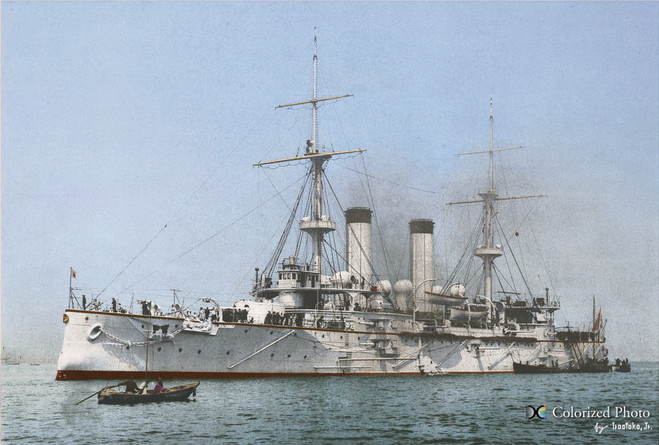
IJN Tokiwa prior to 1922 – colorized by Hirootoko Jr (cc)
But it was revised later as these new figures were estimated still insufficient to take on the Russian Pacific fleet and the plan shifted to the “Six-Six Fleet”. Asama and her sisters were to be used as fleet cruisers, intended to be part of the battle line/Fleet scouts and not to act as commerce raiders or distant stations and trade routes protection. This plan included the Asama and her sister-ship Tokiwa, the German-built Yakumo, French-built Adzuma, and the Idzumo class, all launched in 1898-99, later joined by the two Italian-built Kasuga.
This generation of orders was also a convenient way for Japanese engineering to “sample” foreign naval constructions when setting up the first domestic naval yard. In addition these ships often (as the case for Asama and Tokiwa) participated in four wars: Russo-Japanese, WW1, 2nd Sino-Japanese War, and WW2.
Design of the Asama
Asama and Tokiwa were Philipp Watts’ export design, and they were very similar to the Chilean O’Higgins. Homogeneous and well balanced, they were quite successful. 134.72 oa by 20.45 m long (442 x 67 feets) they were a good compromise between speed, agility and stability. The German-built Yakumo was narrower and slightly lighter, as well as the Adzuma.
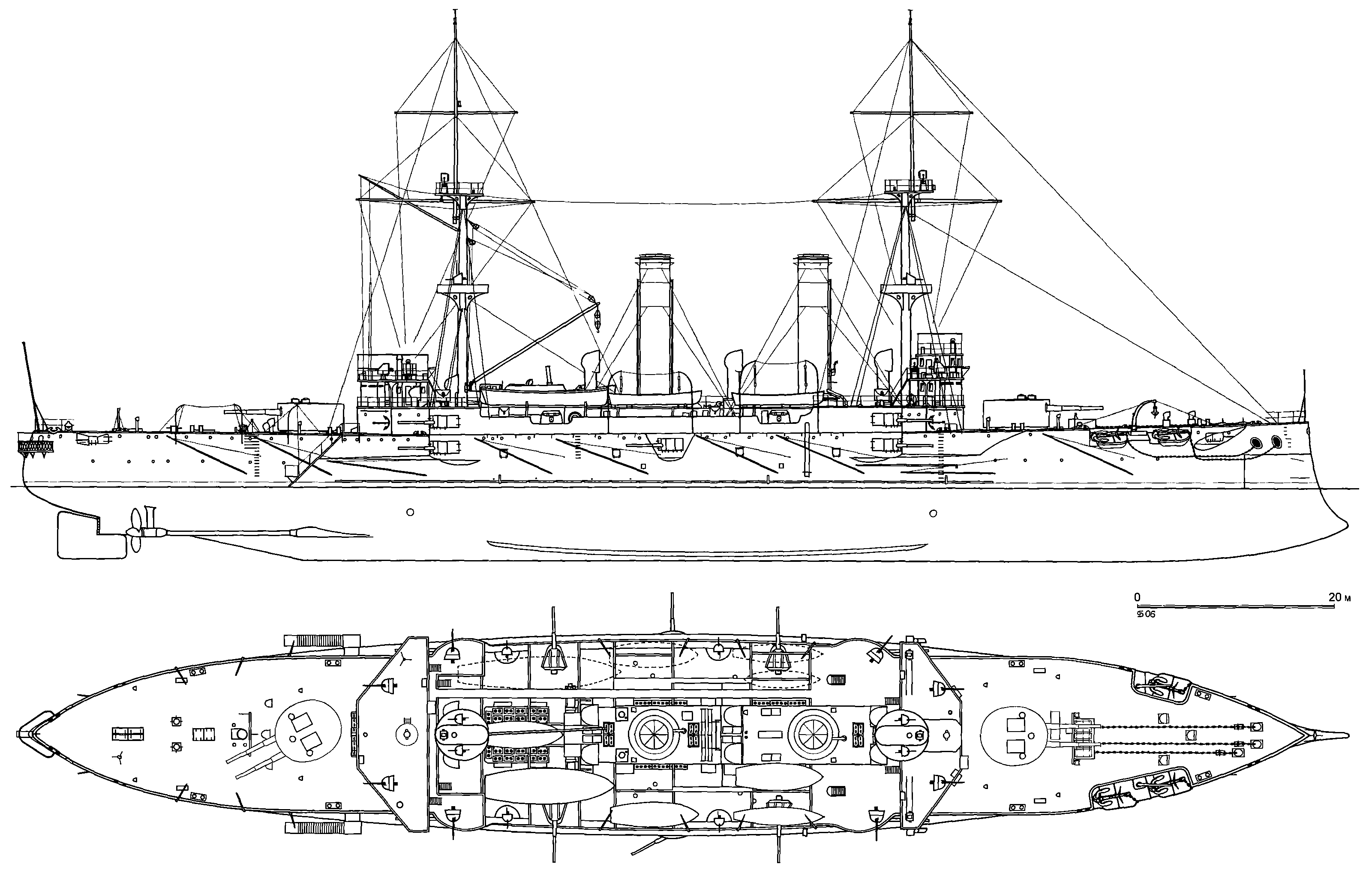
Large HD blueprint of the Asama class (src unknown)
Powerplant
The Asama class used two shafts propellers, mated each to a 4-cylinder triple-expansion steam engine. Steam was provided by twelve cylindrical single-ended, coal-burning boilers. Total Rating was 18,000 indicated horsepower (13,000 kW), the best figure of all armoured cruisers in the same plan. Their designed speed of 22 knots (41 km/h; 25 mph) was beaten on trials at 22.07 knots (40.87 km/h; 25.40 mph) at 19,000 ihp (14,000 kW), but the generally accepted figure was 21-1/2 knots in service.
This was still one knot faster than all other cruisers of the plan. They carried a total of 1,390 long tons (1,410 t) of coal (600 in peacetime), allowing a 10,000 nautical miles (19,000 km; 12,000 mi) radius at 10 knots and according to Conway’s 4500 nm at 11.5 knots.
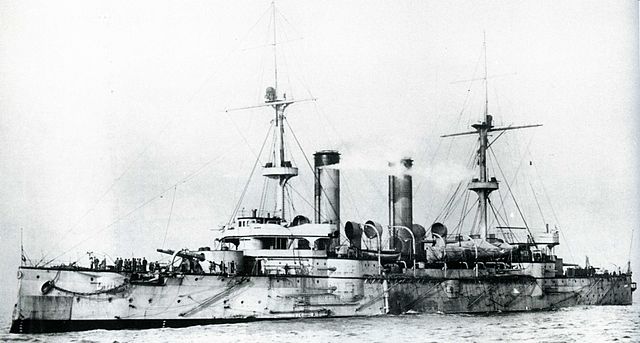
IJN Asama after completion in 1900
Protection
The Asama and Tokiwa protection scheme was about the same as all other cruisers of the plan. However both cruisers used less tough Harvey armor. They had a full-lenght waterline belt 178 mm (7.0 in) at the thickest amidships down to 89 mm (3.5 in) on both ends. This belt was 2.13 m (7 ft 0 in) high, with 1.52 m (5 ft 0 in) underwater. The upper strake was 127 mm (5.0 in) thick, running from the upper edge of the waterline belt to the main deck, 65.42 m between barbettes.
In addition the citadel comprised 127 mm armored bulkheads. Turrets and casemates were protected by 6-in (152 mm) but the strongest element was the conning tower, which was 14-in thick (356 mm) with a 5 in roof (127 mm), which meant virtual impunity from battleship fire. These figures were repeated for all IJN armoured cruisers of the same order, as specified by the Japanese to the various yards contractually.
Armament
The main armament for all of the “Six-Six Fleet” was contractually about the same; Two twin turrets, 8-in guns, and 12 to 14 6-in guns (125 mm) in barbettes, with more diversity for light guns.
Main guns: Four eight-inch guns in twin turrets fore and aft of the superstructure. They were EOC 8 inch 45 caliber manufactured by Elswick and derived from the 1894 Elswick Ordnance Pattern Q gun for export. More specifically they were of the Pattern U group (Asama class, Adzuma, Izumo class and Yakumo). They weighted 19 t (19 long tons) for 9.5 m (31 ft 2 in) in all and a 7.8 m (25 ft 7 in) 45 caliber barrel, and used a separate loading bagged charge and projectile system. Their shell weight was 116 kg (256 lb), and average rate of fire 2 rpm. Shells (AP types) existed the barrel at a muzzle velocity of 790 m/s (2,600 ft/s) while their range was 18 km (11 mi) at 30° elevation. Outside Japan the only other user of this piece of ordnance was Chile, on the Chacabuco.
Secondary guns: 14 Elswick “Pattern Z” quick-firing (QF) 6-in (152 mm) guns: Most but four were mounted in armored casemates on the main and upper decks (with forward and aft broadside two-stage barbettes), and upper deck, protected by gun shields.
Tertiary armament: Twelve QF 12-pounder 12-cwt guns and eight QF 2.5-pounder Yamauchi guns. Thy all served for close-range anti-torpedo boats.
Torpedo armament: As customary for the time, the Asama class received five 457 mm (18.0 in) torpedo tubes. One was above water, bow-firing and the other four were submerged, on the broadside;
Specifications in WW1
Displacement: 9700t Standard, 10,520t FL
Dimensions: 135 x 20.45 x 7.4 m
Propulsion: 2 shafts VTE, 12 boilers, 18,000 hp. and 21.5 knots
Armor: max. belt, turrets, casemates 152 mm (6 in); CT 356 mm (14 in)- see notes
Crew: 726
Armament: 4 x 203 (8 in), 14 x 152 (6 in), 12 x 76 (3 in), 7 x 45 (2 in), 5 x 457 mm (18 in) flanks and bow TTs.
The Asama class in action
IJN Asama and Tokiwa had a long career, both taking part in the battle of Tsushima, receiving rather serious damage. Repaired, they served during the Great War. In 1923 their fate seemed sealed, but IJN Asama was partially disarmed and served as a training ship while IJN Tokiwa was converted as a minelayer.
She was partially rebuilt to carry 300 mines. In 1927 she suffered an accidental mine explosion and was placed in reserve. She resumed service during the Sino-Japanese War of 1937, rebuilt to carry 500 mines this time, and seeing her AA strengthened. She was hit by a mine in 1945, and later sank by USN aviation. Asama suvived the war and was broken up in 1947.
IJN Asama’s career
The ship had already been laid down in Elswick on 20 October 1896 as a speculative venture. The contract however was only signed on 6 July 1897 with the Yard. Construction proceeded swiftly and the IJN Asama was launched on 21 March 1898, completed on 18 March 1899, leaving for Yokosuka in May and first time featured during the naval review on 30 April 1900, hosting Emperor Meiji. Two years after he ship was present at the Coronation Review for King Edward VII in Spithead, touring northern Europe and the Mediterranean.
Russo-Japanese War
Asama was part of the 2nd Division of the 2nd Fleet, then attached to the 4th Division of Rear Admiral Uryū Sotokichi to operate around Seoul, escorting ships with troops to Chemulpo, and participated in the destruction of the protected cruiser Varyag and gunboat Korietz. However war was only notified the next day at dawn on 8 February 1905 whereas a surprise attack was made during the night Port Arthur. The duel with Varyag was paid in return by at least two hits, her bridge being badly damaged and a hole below her waterline provoking some list.

Postcard of the Asama in 1905
Repairs were done after the ship joined Vice Admiral Kamimura Hikonojō’s 2nd Division, making a diversion off Vladivostok, shelling the port and coastal defences. After escorting ships carrying the Imperial Guards Division to Korea, she went back to Japan and returned later Rear Admiral Dewa Shigetō’s 3rd Division and the combined fleet. By 13 April, the battle under Admiral Togo began, IJN Asama duelling with the head of the line, composed of Russian cruisers.
She blockaded Port Arthur afterwards and participated in the battle of the yellow sea on 10 August 1904. In fact she near-missed it as she was coaling when the Russians sortied and had to cut the operations short, speeding ahead at 19:00, opening fire at 9,000 meters (9,800 yd) on the damaged Russian battleship Poltava, soon reinforced by cruisers. Asama duelled fiercely at 7,500 meters (8,200 yd) with the Poltava before being forced to disengage. On 14 August with the 3rd Division she proceeded to Tsingtao to confirm the internment of Tsessarevitch by the Germans. She was back home for repairs in December;
On 27 May, back in the area she participated in the Battle of Tsushima, and Asama opened fire, fifth of six in the line, 14:10 engaging the battleship Oslyabya. She was hit in return by a 12-in shell, knocking out her steering mechanism, and making her leaving the line to repair, made in six minutes, however she received soon two more hits, provoking a serious flooding.
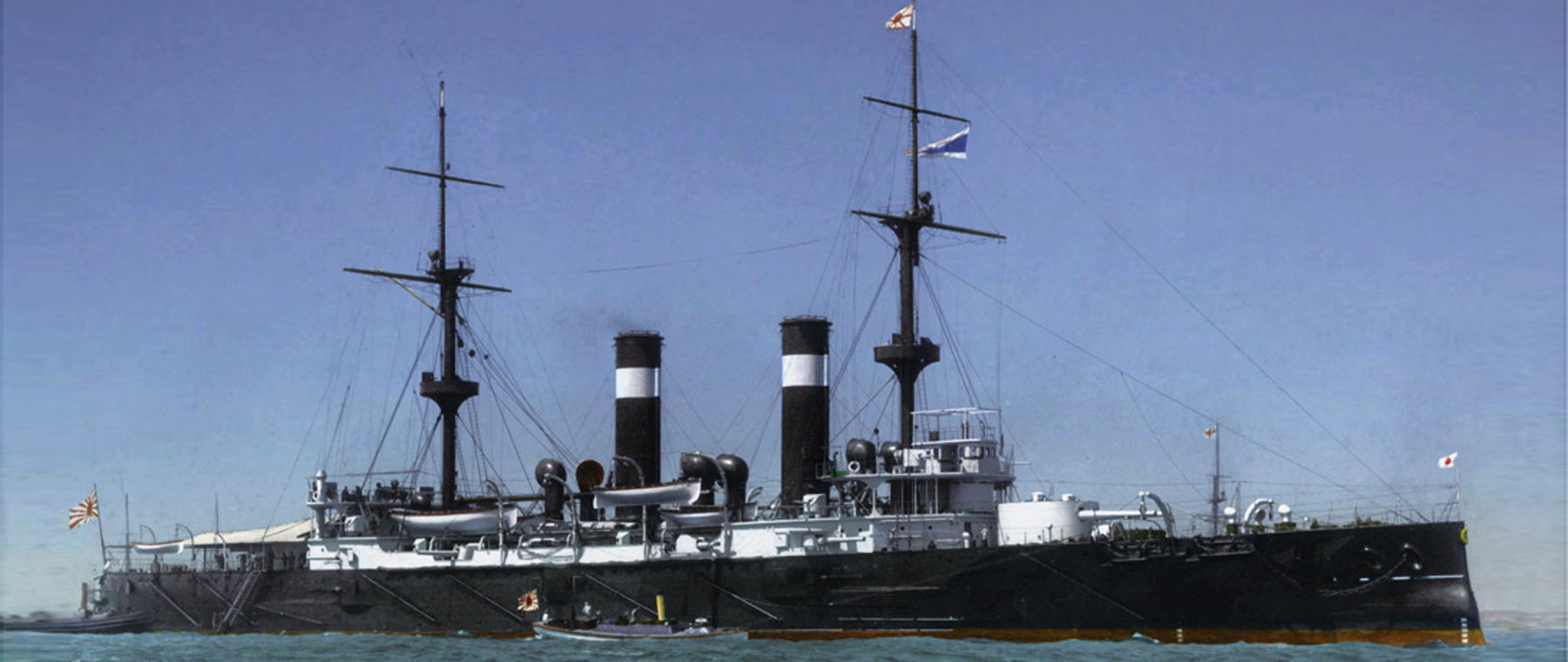
Asama in 1902 – colorized by Hirootoko Jr.
Later she has still not rejoined the line when she was struck at rear funnel, reducing her boiler draught and slowing her down even more. During the night sh was stopped for more repairs. She was back in operations the next day and ordered by Tōgō to join the pursuit with the 4th Division but only saw the Donskoi scuttled in shallow water. It is estimated that IJN Asama took 12 hits of various caliber, loosing 11 men and having 13 wounded.
After repairs she carried the Emperor again in a victory naval review, and joined the Training Squadron from 1 June 1910 to 1 April 1911 making later a tour with naval cadets to th US Coast and Hawaii. She made a dozen more cruises until 11 August 1914.
IJN Asama during the Great War
When the war broke out, Asama joined the 1st South Seas Squadron, searching for Vice Admiral Max Von Spee’s German East Asia Squadron in the South Sea Islands. In October she trapped in Honolulu the German gunboat SMS Geier, and later the joined American Expeditionary Squadron at Magdalena Bay, Baja (Cal.) in order to track German commerce raiders. Informed of the battle of the Falklands she squadron was rerouted to the western coast of Central America but arrived too late. Back in California, Asama struck an uncharted rock at the entrance to the bay in 31 January 1915.
She was later assisted by the Izumo and later Tokiwa, and the repair ship Kamakura Maru. On 8 May she was refloated and sailed for the British naval base at Esquimalt, British Columbia, for provisional repairs, and was back to Yokosuka on 18 December. She was not only repaired but modernized, with the fitting of 16 Miyabara water-tube oil-firing boilers and removal of her bow torpedo tube; Back in service in March 1917 she served as flagship of a Destroyer Squadron and later Training Squadron for multiple cruises until the end of hostilities.
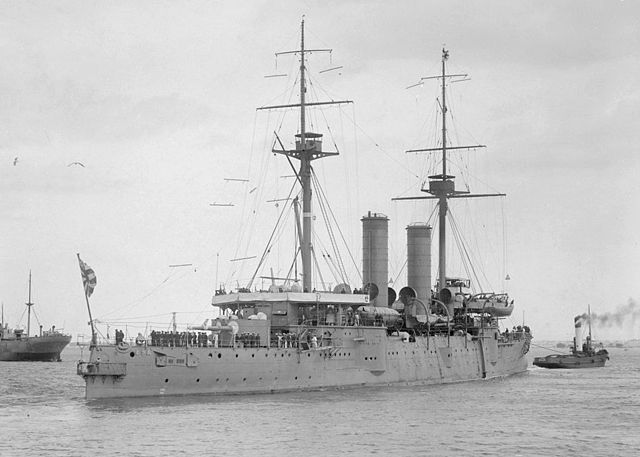
Asama as a cadet training ship towed off port in Australia circa 1923
Interwar and ww2 as training ship
IJN Asama made numerous long range oceanic navigation training by officer candidates, and was reclassified as 1st class coast defense ship on 1 September 1921. For this, she was disarmed: Her main deck guns, six of her 6-in and four 12-pdr were removed, all QF 2.5-pdr guns and casemates plated over while she received a single 80mm/40 3rd Year Type AA gun. She toured the world until she ran aground on the night of 13 October 1935, NNW of the Kurushima Strait.
The damaged was such that after being towed to Kure it was estimated repairs would not be worth it and she was summarily repaired to be anchored permanently in Kure Naval Arsenal as stationary training ship from 1938 to 1942, reclassified as training ship in 1942, towed to Shimonoseki to serve as a gunnery training ship. Eventually later she was totally disarmed, only retaining some 8 cm/40 AA guns, stricken in November 1945 and BU in 1947 at Innoshima.
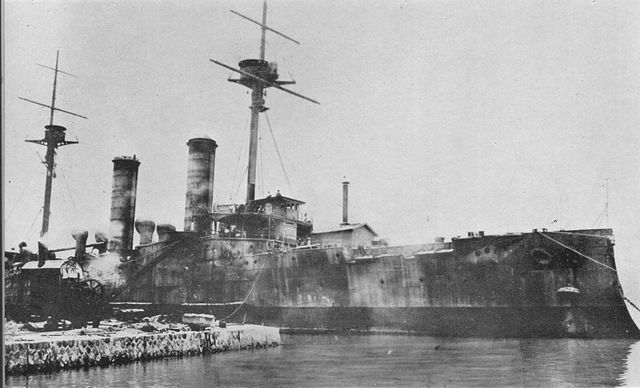
Asama in 1946
IJN Tokiwa’s career
Like her sister ship, Tokiwa was laid down on 6 January 1897 as a speculative venture, launched on 6 July 1898 and completed on 18 May 1899. She was taken command after arriving in Yokosuka on 16 July by Captain Dewa Shigetō, and later under Nakayama Nagaaki, supported Japanese troops during the Boxer rebellion.
Russo-Japanese War
Towika participated in the Russo-Japanese war. She was assigned to the 2nd Division of the 2nd Fleet when participating in the Battle of Port Arthur on 9 February 1904. In early March 1905, Tokiwa was reassigned to Rear Admiral Dewa’s 3rd Division and later attempted to capture the disabled destroyer Steregushchiy, only to be driven back by coastal batteries. On 13 April during the battle of the Yellow sea, Tokiwa engaged first the heading Russian cruisers before falling back to the battleships.
Later Toikwa joined the 2nd Division under Kamimura, sent to patrolling the sea of Japan in mid-April and to defend the Korea Strait. Rear Admiral Karl Jessen was sent to unite with the Pacific Squadron but near-missed the Tokiwa’s squadron in the fog. She was later off Vladivostok, covering minelaying operations. The forces misses again one another but at last a clash started near Okinoshima at dawn. The Russians were able to escape in the night. Jenssen made another sortie 17 July, passed through Tsugaru Strait and started capturing Japanese trade vessels. At last on 10 August, Tokiwa participated in the battle of Ulsan.
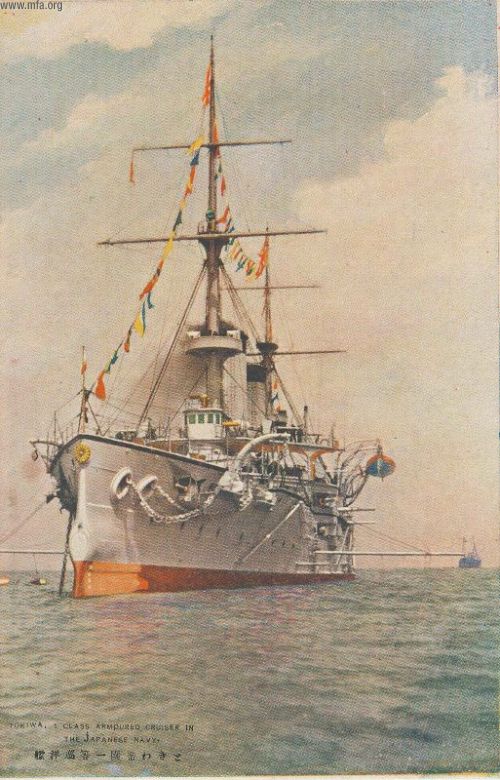
Jenssen tried to rally port Arthur from Vladivostok with Rossia, Gromoboi, and Rurik, and was eventually met by Kamimura’s squadron, comprising Iwate, Izumo, Azuma, and Tokiwa. Borth squadrons crossed each others during the night, but eventually changing cours they spot each other again at noon. Tokiwa chased Rurik and only suffered three men wounded during the battle. By mid-September Tokiwa was transferred to the 1st Division and in November she was refitted at the Kure Naval Arsenal. She was back for an escort mission at Wonsan on 2 February and in refit again. On 27 May she participated in the Battle of Tsushima.
At 17:30 Kamimura led his division in a desperate chase pursuit of some of the Russian cruisers before turning back to Tōgō’s battleships and engaging the Russian line until dawn. As for previous battles, Tokiwa emerged relativel unscaved; with one large and seven small hits (3 in shells) and deplored one crewman killed and fourteen wounded. In preparation to invade Sakhakline in June the 2nd Division reduced to Iwate, Izumo, and Tokiwa, was sent to defend the Korea Strait. Later Tokiwa’s squadron covered in August the landings at Chongjin.
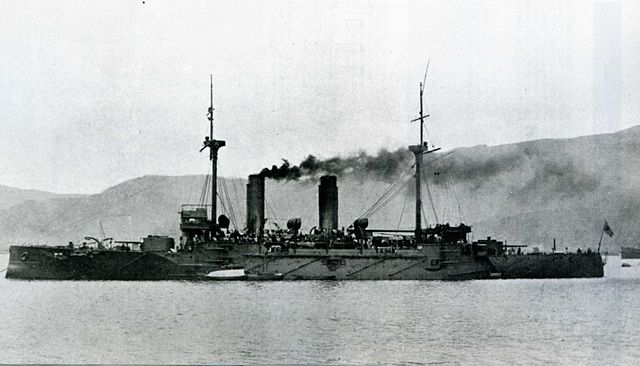
Tokiwa in WW1
In 1910 Tokiwa was refitted again in drydock, received Miyabara water-tube boilers and modern Japanese six-inch guns. Iwate and Tokiwa were deployed to Port Arthur during the Chinese revolution, and Tokiwa participated in the blocus and shelling of Tsingtao in August-October 1914. Sh went back to Sasebo and emerged to be deployed off Singapore, trying to intercept the SMS Emden.
However she was getting old and from 1916 in September she was tasked wth the Training Squadron, touring the USA with cadets, Hawaii and the South Sea Islands. At Honolulu she was deployed to relieve the US Navy of searching for German commerce raiders and be redeployed in the Atlantic convoys. Back with trainuing duties, Tokiwa on 10 August 1918 teamed with Azuma in a new cruiser round the world, visiting from March 1919 South Asia and Australia, Singapore, Southeast Asia, Suez Canal and the Mediterranean Sea.
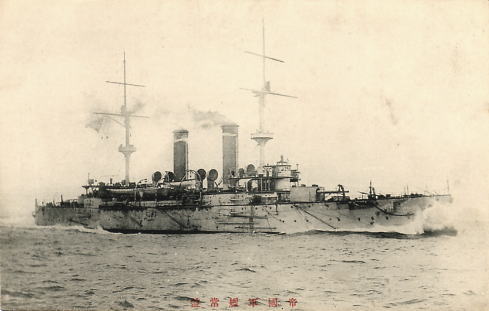
Tokiwa as a minelayer in WW2
From 1921, Tokiwa was reclassified as a 1st class coast-defense ship and from September 1922, Tokiwa began her conversion into a minelayer at the Sasebo Naval Arsenal. As reconstructed she was deprived of her aft 8-in gun turret, to accomodate 200–300 mines on her deck. Her six 6-inch deck guns were aso removed. Her light armament was reduced to just two 12-pdr while their AA battery was now reinforced by two 8 cm/40 3rd Year Type guns. They were also modifications of the bridge, masts, superstructure, which were completed by March 1924.
She served with the 1st Fleet from January 1932 to May 1933 durinf the invasion of Mandchuria. In 1937-1938, she was retrofitted with eight Kampon boilers, dividing her output drastically to make room for 500 mines; Top speed fell to 16 knots (30 km/h; 18 mph). Her remaining torpedo tubes were removed also. She was in 1939 assigned with the 4th Fleet, 18th Division, and 19th Division in 1940, under Rear Admiral Kiyohide Shima. The same year she was refitted again as a training minelayer, with 300 mines. Her forward 8-in gun turret was deposed, four amidships 6-in guns, one 8 cm/40 AA guns whereas she received 2 single 40 mm (1.6 in) guns and 20 Hotchkiss Type 96 25mm guns.
In December 1941, IJN Tokiwa escorted troop transports bound to for Makin and Tarawa in the Gilbert Islands. In January 1942 sheparticipated in Operation R (invasion of Rabaul and Kavieng), and was back to Kwajalein where she was attacked by USS Enterprise’s air group, and in February 1942 sent to Sasebo for repairs. She returned to Truk atoll this time, and later in August 1942, was assigned to the task force bound to Makin Atoll. In May 1943, she was reassigned to the Ōminato Guard District for escort duties from Truk to Yokosuka and back, and later reassigned to the 18th Escort Squadron, 7th Fleet on 20 January 1944. Her AA armament was changed again for escort missions with ten 25 mm Type 96 AA guns and 80 depth charges and search and surveillance radars.
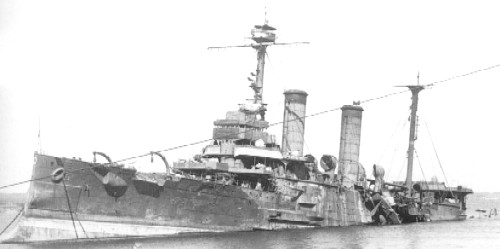
She laid mines off Okinawa June 1944 and Yakushima in February 1945. The irony was she hit a mine on 14 April 1945 off Hesaki, Kyūshū and later was again damaged by mines laid by B-29 Superfortresses in June 1945. She met air fate during an air attack off Ōminato in Mutsu Bay, 9 August 1945, led by planes from the USN TF 38. Her crew managed to beach her. Removed from the list on 30 November 1945 she was refloated and towed to a ship-breaker on 5 April 1947.
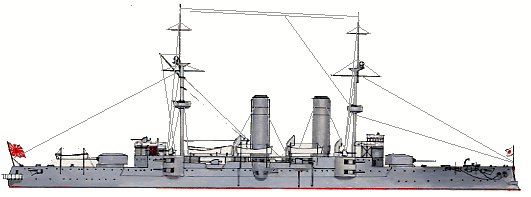
IJN Asama during WW1 – Author’s illustration.
Read More/Src
John Gardiner – Conway’s all the world’s fighting ships 1865-1905
https://en.wikipedia.org/wiki/Japanese_cruiser_Asama
https://en.wikipedia.org/wiki/Japanese_cruiser_Tokiwa
https://en.wikipedia.org/wiki/Asama-class_cruiser
http://www.fr.naval-encyclopedia.com/1ere-guerre-mondiale/navires-japonais1914.php#crois


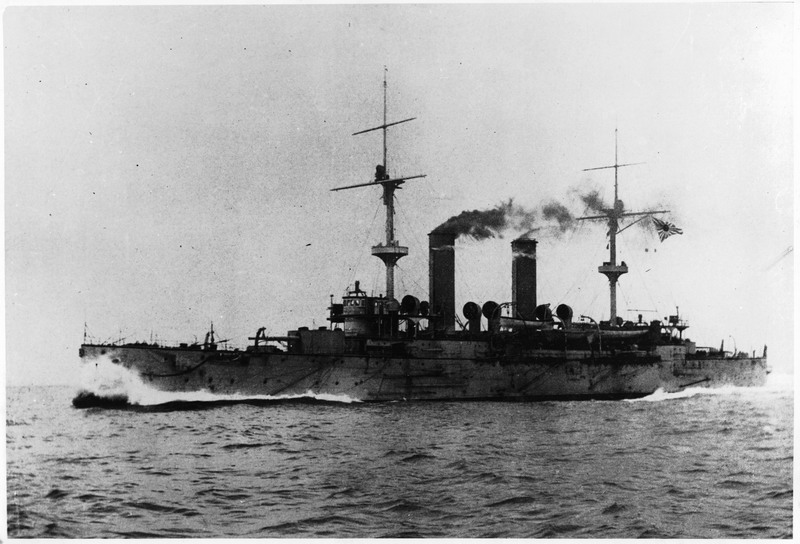
 Latest Facebook Entry -
Latest Facebook Entry -  X(Tweeter) Naval Encyclopedia's deck archive
X(Tweeter) Naval Encyclopedia's deck archive Instagram (@navalencyc)
Instagram (@navalencyc)





 French Navy
French Navy Royal Navy
Royal Navy Russian Navy
Russian Navy Armada Espanola
Armada Espanola Austrian Navy
Austrian Navy K.u.K. Kriegsmarine
K.u.K. Kriegsmarine Dansk Marine
Dansk Marine Nautiko Hellenon
Nautiko Hellenon Koninklije Marine 1870
Koninklije Marine 1870 Marinha do Brasil
Marinha do Brasil Osmanlı Donanması
Osmanlı Donanması Marina Do Peru
Marina Do Peru Marinha do Portugal
Marinha do Portugal Regia Marina 1870
Regia Marina 1870 Nihhon Kaigun 1870
Nihhon Kaigun 1870 Preußische Marine 1870
Preußische Marine 1870 Russkiy Flot 1870
Russkiy Flot 1870 Svenska marinen
Svenska marinen Søværnet
Søværnet Union Navy
Union Navy Confederate Navy
Confederate Navy Armada de Argentina
Armada de Argentina Imperial Chinese Navy
Imperial Chinese Navy Marinha do Portugal
Marinha do Portugal Mexico
Mexico Kaiserliche Marine
Kaiserliche Marine 1898 US Navy
1898 US Navy Sovietskiy Flot
Sovietskiy Flot Royal Canadian Navy
Royal Canadian Navy Royal Australian Navy
Royal Australian Navy RNZN Fleet
RNZN Fleet Chinese Navy 1937
Chinese Navy 1937 Kriegsmarine
Kriegsmarine Chilean Navy
Chilean Navy Danish Navy
Danish Navy Finnish Navy
Finnish Navy Hellenic Navy
Hellenic Navy Polish Navy
Polish Navy Romanian Navy
Romanian Navy Turkish Navy
Turkish Navy Royal Yugoslav Navy
Royal Yugoslav Navy Royal Thai Navy
Royal Thai Navy Minor Navies
Minor Navies Albania
Albania Austria
Austria Belgium
Belgium Columbia
Columbia Costa Rica
Costa Rica Cuba
Cuba Czechoslovakia
Czechoslovakia Dominican Republic
Dominican Republic Haiti
Haiti Hungary
Hungary Honduras
Honduras Estonia
Estonia Iceland
Iceland Eire
Eire Equador
Equador Iran
Iran Iraq
Iraq Latvia
Latvia Liberia
Liberia Lithuania
Lithuania Mandchukuo
Mandchukuo Morocco
Morocco Nicaragua
Nicaragua Persia
Persia San Salvador
San Salvador Sarawak
Sarawak Uruguay
Uruguay Venezuela
Venezuela Zanzibar
Zanzibar Warsaw Pact Navies
Warsaw Pact Navies Bulgaria
Bulgaria Hungary
Hungary

 Bundesmarine
Bundesmarine Dutch Navy
Dutch Navy Hellenic Navy
Hellenic Navy Marina Militare
Marina Militare Yugoslav Navy
Yugoslav Navy Chinese Navy
Chinese Navy Indian Navy
Indian Navy Indonesian Navy
Indonesian Navy JMSDF
JMSDF North Korean Navy
North Korean Navy Pakistani Navy
Pakistani Navy Philippines Navy
Philippines Navy ROKN
ROKN Rep. of Singapore Navy
Rep. of Singapore Navy Taiwanese Navy
Taiwanese Navy IDF Navy
IDF Navy Saudi Navy
Saudi Navy Royal New Zealand Navy
Royal New Zealand Navy Egyptian Navy
Egyptian Navy South African Navy
South African Navy






























 Ukrainian Navy
Ukrainian Navy dbodesign
dbodesign